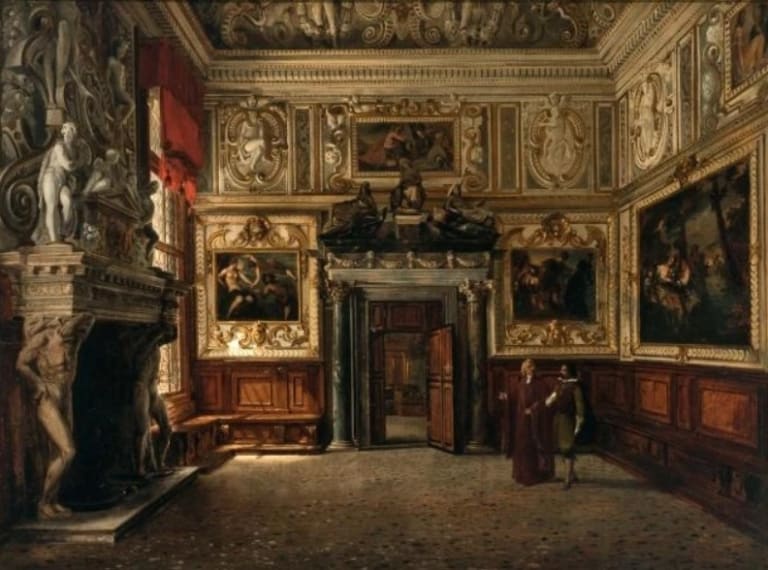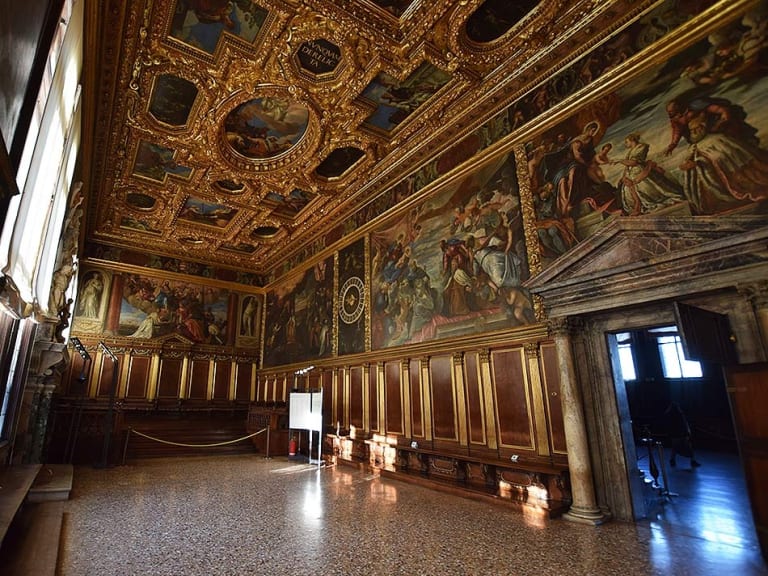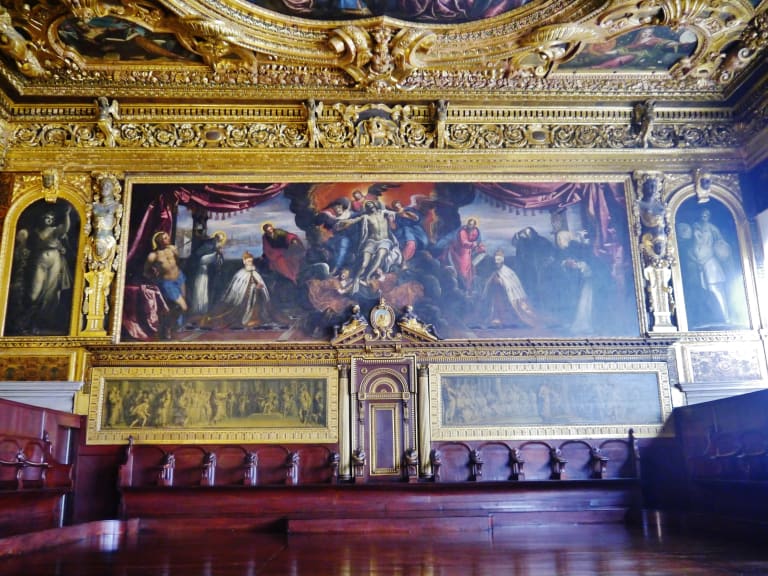More about: Things You Can´t Miss at the Doge's Palace in Venice
When talking about the Doge's Palace, we are talking about one of the main tourist attractions of Venice, an obligatory stop for all visitors, it is almost impossible to find St. Mark's Square without tourists even during the off-peak seasons. The reason for the popularity of this unique building is due to two main reasons: the breathtaking beauty of its architecture and the large number of works of art housed inside.
If you already have your tickets for the Doge's Palace, here are the highlights you should not miss, so you can enjoy the tour even more.
The Opera Museum

Located in what was once a technical office in charge of maintenance work at the Palace, the Opera Museum exhibits important pieces from the palace's past. Throughout its history, the Ducal Palace has been restructured several times due to fires, structural failures and the deterioration of time.
Starting in 1876, a major restoration plan was put into action: it covered the two main façades and the capitals on the first floor. 42 capitals were replaced by copies, the originals after an exhaustive repair were placed together with other sculptures of the facade in the Opera Museum. This space is ideal to admire up close details of original pieces that in other scenarios would be impossible to see.
Courtyard

The Doge's Palace is among the most important monuments of Venice of the Serenissima. While it is true that all the elements that make up the outer facade of the Doge's Palace correspond to impressive architectural landmarks and true Venetian icons; it is no less true that the inner courtyard is equally impressive. From this area you can appreciate at a quick glance the internal facades of the three wings of the Palace.
The Porta della Carta is the element that leads through the Foscari Arch from St. Mark's Square to the central courtyard. The entire façade of the courtyard is a clearly Renaissance work with a rich succession of arcades and ornaments made of pilasters, friezes and oculi. Next to the Arco del Foscari is the beautiful clock façade, made in 1615 by Monopola.
Monumental Stairs

At the Doge's Palace details are everywhere you look; two important highlights are its main staircases.
Staircase of the Giants
It connects the central inner courtyard of the palace with the internal logic on the second floor. It was, in former times, the space where the traditional ducal coronation ceremony was performed. Crowned at the top with two colossal statues (the giants) who represented the dominion of the great Venice over sea and land. The statues carved in marble by Sansovino represent Mars and Neptune and were placed in 1567.
Golden Staircase
Also called the Golden Staircase, it is the natural continuation of the Staircase of the Giants and is located inside the Palace. It gets its name from the rich decorations in white stucco and gold leaf that cover the vault above the inner staircase executed by Alessandro Vittoria. Along two flights, the golden staircase connects the loggia floor with the two upper floors, each of which is welcomed by a vestibule with large windows.
Hall of the Maggior Consiglio

Built over 15 years between 1340 and 1355, the Hall of the Great Council is considered the most impressive interior space of the Palace, both for its size and for its harmonious proportions and rich decoration. It was used as the seat of the Venetian Parliament chamber implying that, over the centuries, all the weighty decisions involving the city were made here.
When you visit the Doge's Palace and the Sala del Maggior Consiglio you should pay special attention to the ceiling, full of hand-painted panels by Veronese depicting the Venetian city surrounded by the gods and being crowned by Victory. As for the art on the walls you could find works by painters such as Bellini, Titian and Pisanello but much of your work was destroyed in the fire of 1577.
Hall of the Quattro Porte

Located on the second floor of the Palace, the name Quattro Pote refers to the four doors, adorned with fine marble and beautiful sculptures, which serve as access to the hall, and one of the most beautiful architectural features of the entire hall. It was designed by one of the most important Venetian architects of the time, Andrea Palladio; inside the hall you can find frescoes by Tintoretto on the ceiling and paintings by Titian and Tiepolo on the walls.
Before the fire this hall was the seat of the College where the meetings of the lordship were held, later it became the waiting room for the audiences of the Senate and the Signoria.
Anticollegio Hall

In former times, the Sala dell'Anticollegio was the place of honor preceding the residence of the Signoria. The decorative and architectural elements of this hall are also the result of post-fire work, based on the designs of Palladio and Rusconi.
As for the art of the hall we are faced with a magnificent vault covered with richly elaborated stuccoes and frescoes by Paolo Verones. Of particular interest and importance for the history of art are the canvases on the walls displaying works by some of the most prominent Venetian artists of the sixteenth century, such as Tintoretto and Jacopo Bassano.
Hall of the Collegio

The Sala del Collegio is the space inside the Doge's Palace where the meetings of the Cabinet were held in the presence of the Doge; this luxurious hall is also where important visitors were received. The harmony exhibited by its rich interior decoration and the details everywhere you look have earned it the title of the most beautiful hall of the Palace.
Inside, several interesting elements stand out such as the ceiling vault whose eleven paintings are considered the most famous and outstanding work of Paolo Varonesse; the works in turn framed with elaborate wood carvings by talented craftsmen such as Francesco Bello and Andrea da Faenza.
Pay special attention to the large Veronese painting of 1578 on display in this room showing the Doge thanking the victory over the Turks, and finally the murals by Tintoretto and his pupils adorn the walls of the room.
Sala del Senato

The Sala delle Quattro Porte is the area that gives access to the Sala del Senato, a sumptuous hall with beautiful decorations that served as a meeting point for the Venetian Senate. It was here that political guidelines and all kinds of important decisions that would define the life and future of Venice were made.
In the artistic field, this room is described by Venetian art experts as "rich and solemn" due to its splendid inlays and the use of golden color in the decoration. The hall was designed by Andrea Palladio, when visiting this majestic space you will find, as in the rest of the Doge's Palace, exquisite works of art by artists such as Tintoretto and Jacopo Palma.
Hall of the Consiglio dei Dieci

Don't leave the Doge's Palace without visiting the Consiglio dei Dieci, a space that shows a slightly darker side of the history of this beautiful city. The Hall of the Council of Ten was a sort of secret state court that worked in conjunction with the Venetian secret police to control all aspects linked to the public and private life of the city.
In our times nothing remains of the original furnishings of the hall. Made up of wood paneling and exquisite paintings you should pay special attention to the frescoes on the luxurious ceiling, among them: "Jupiter throwing lightning bolts against vices" by Veronese (a copy because the original was confiscated by Napoleon and is in the Louvre) and "Juno offering the ducal crown to Venice" also by Veronese.
Armory of the Palace

If you have a taste for strange objects from other times or if you have any kind of interest in Venice's military past, be sure to tour the Armory room in the Doge's Palace.
Initially used as a simple warehouse for armaments, today the room has been reconditioned and arranged to present an extraordinary collection of 15th and 16th century armor, crossbows, swords and maces. Here you will also find rudimentary firearms of the time, one of them called arquebus considered by historians the forerunner of the modern machine gun.
Facades

Considered one of the masterpieces of Venetian Gothic architecture, the first thing you should admire in the Doge's Palace are its imposing facades. The heavy structure seems to make an allegory to Venice, where the solid mass that make up the top floor of the palace rises on delicate columns of Istrian marble.
Facade towards the quay
Considered one of the two main facades of the Palace, the dock facade is 71.5 meters long and is developed over 17 arches. The first two colonnaded levels are crowned on the surface by an imposing floor in inlaid marble where elegant windows with pointed arches were placed. On this side is located the public entrance to the palace, through the Porta del Frumento.
Facade towards the Piazzetta
Being practically identical to the façade of the quay in shape and design, the façade towards the square is a little longer with its 75 meters in length and was built in later years.
Facade facing the Rio di Palazzo
The most recent wing of the complex is the lateral facade facing the Rio di Palazzo, built in 1483 after the fire that devastated a large part of the Palazzo Ducale. On this façade was placed the famous Bridge of Sighs that connects the Palace with the new prisons.
Porta della Carta

The large gate serves as a connecting point between the Doge's Palace and St. Mark's Basilica. Its name translates into English as "Letter Gate" and it is believed to come from the times when Venetians used to wait in front of it to deliver their petitions to the authorities.
Created in the 15th century by the Bon brothers, it is considered, along with Ca' d' Oro, as one of the best manifestations of the Venetian flowery Gothic style. The majestic gate exhibits hand-carved ornamental figures with an allegorical figure of the duxFrancesco Foscari kneeling before the Lion of St. Mark and the statues of Adam and Eve. The decorative sculptural section of the gate was once painted in gilding; it is complemented by the ornamentation of columns, niches and towers.
Ponte dei Sospiri

The Bridge of Sighs was built in 1614 to connect the Ducal Palace with the building destined for the New Prisons. The bridge crosses the Rio del Palazzo and its external architecture, which cannot be appreciated in an internal tour, shows clear baroque influences. If you want to appreciate in detail the architecture of the bridge you should go to the front of the pier, and climb the Ponte della Paglia, from this point you can take magnificent pictures of the Ponte dei Sospiri.
The unique name was coined to the small windows that make up the closed structure of the beautiful bridge. Some stories tell that through these gaps of light, the hopeless condemned observed for the last time the beautiful lagoon and sighed in fear of the fate that awaited them.
Prisons

Regular admission to the Doge's Palace does not include access to the prison area or to the space where, in 1755, the intrepid Giacomo Casanova made his legendary escape. However, some private tours and excursions take small groups of tourists through the subway, damp and dimly lit cells of the palace.
Access to this area is via the Bridge of Sighs, listed as one of the most beautiful of all Venetian bridges. If you have the opportunity to walk through the gloomy and uninhabitable prisons you will understand the despair and anguish of the condemned souls who suffered in their own flesh the agony of confinement.
In cell number 10 of the pozzi was locked up in 1549 Riccardo Perucolo accused of Lutheran heresy during the time of the Inquisition, years later a painting of Riccardo was found buried in the earth and lime.



